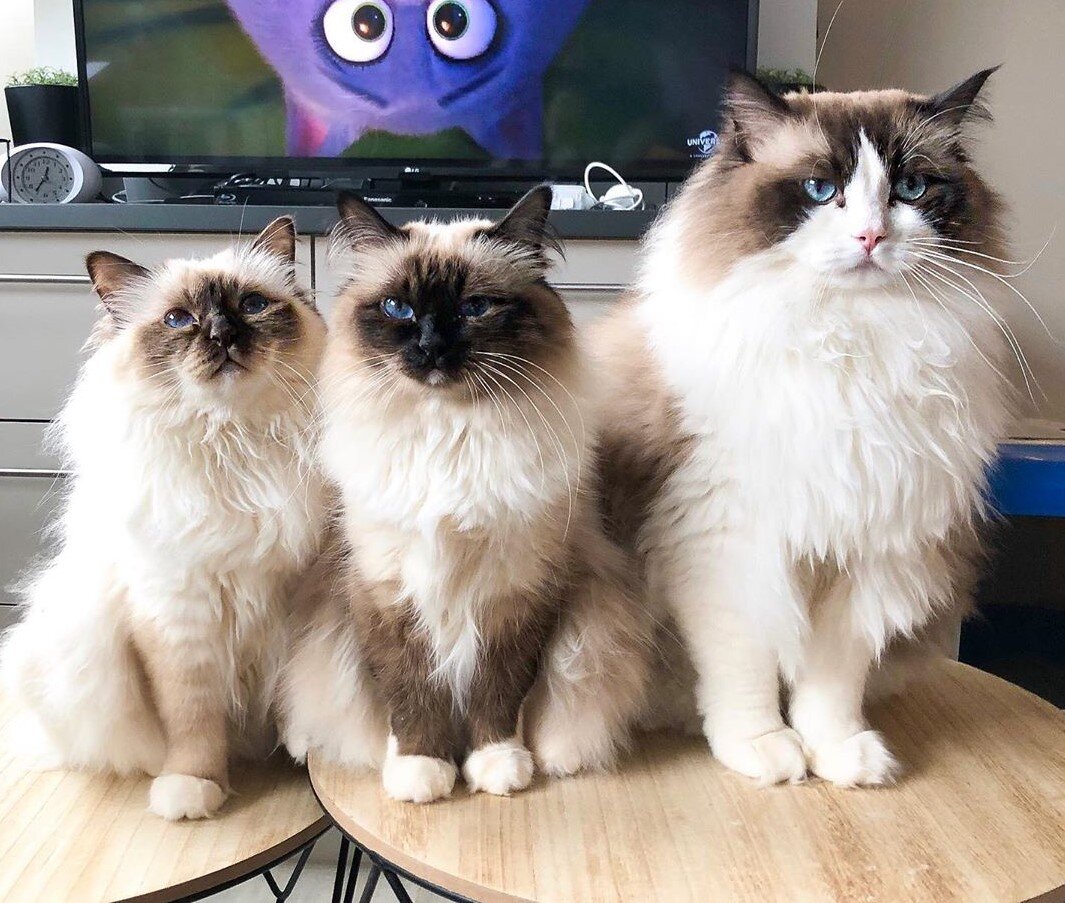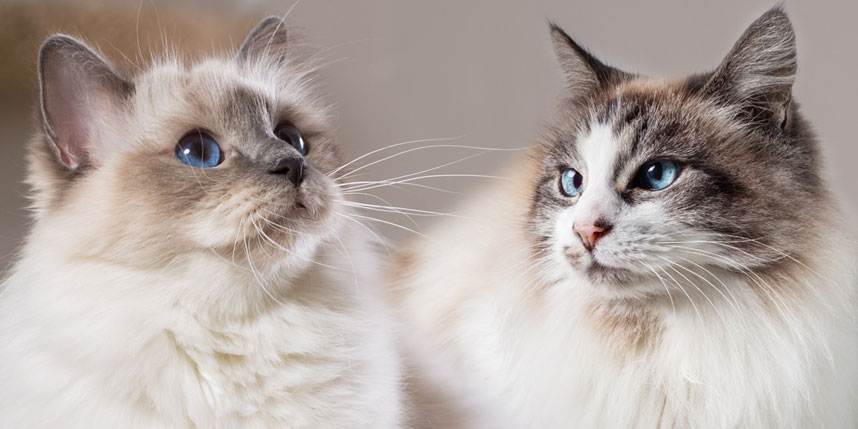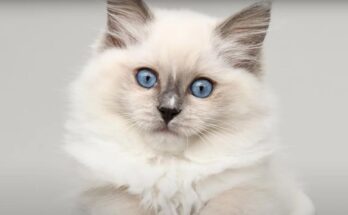Ragdolls are larger, with more intense blue eyes and a distinct color-point coat. Birmans have sturdy bodies, less intense blue eyes, and white “gloves” on their paws.
The Ragdoll and Birman cats often captivate cat enthusiasts with their striking appearances and amiable natures. Recognized for their placid and affectionate personalities, these breeds both boast semi-long coats and captivating blue eyes that charm people at first glance. Originating from different backgrounds, the Ragdoll emerged in the 1960s in California, while the Birman’s history stretches back to Burmese temples.
Despite their similarities, the distinct size and coat patterns of these breeds make it easy for cat lovers to tell them apart. Cat owners treasure Ragdolls for their tendency to go limp when held, and Birmans for their mysterious gaze and unique white markings. Both breeds make excellent companions, bringing elegant beauty and soft-voiced charm into a pet lover’s home.

Credit: thelittlecarnivore.com
Distinct Lineage
The Ragdoll and the Birman cats might look similar at first glance. Both flaunt luxurious coats, stunning blue eyes, and a friendly demeanor. Yet, their backgrounds tell a different tale. Digging into their distinct lineage reveals unique histories and captivating lore tied to each breed.
Origins Of The Ragdoll
The Ragdoll cat breed emerged in the 1960s in California. A woman named Ann Baker is credited with developing this breed. She bred a domestic longhaired white female with other free-roaming cats. The resulting kittens had gentle, docile temperaments and a tendency to go limp when picked up, which led to the name ‘Ragdoll’.
- Developed: 1960s
- Location: California, USA
- Breeder: Ann Baker
- Key Feature: Goes limp when held
Birman Cat Ancestry
Birman cats have a mythical past. Legends suggest that they were the companions of temple priests in Burma. European adventurers discovered them and brought them to France in the 1920s. An official breed standard was later established, cementing their status as pedigreed Birmans.
| Century | Location | Event |
|---|---|---|
| 20th | Burma & France | Breed discovery and standardization |
| 21st | Worldwide | Recognition as purebred |
It’s fascinating to explore the history behind these charming felines. Despite their similar appearances, they sprang from different parts of the world. This rich heritage is part of what makes each breed special and adored by cat lovers globally.
Physical Characteristics
Ragdolls and Birmans are stunning felines with distinct physical traits. These gentle giants of the cat world often get mixed up. But, each breed has its unique set of physical characteristics. Let’s dive in and spot the differences that set these fluffy companions apart.
Coat And Color Patterns
The Ragdoll cat boasts a silky, semi-long coat. It feels plush and soft, much like a rabbit’s fur. Ragdolls have a notable color point pattern. This means their ears, face, paws, and tail display darker hues. Their bodies, however, offer a lighter shade. Birmans share a similar color point pattern. They also have a semi-long, luscious coat. A key difference lies in their gloves and laces. Birmans possess striking white feet, giving the appearance of wearing dainty gloves.
Eye Color And Shape
A magical feature of both breeds is their captivating blue eyes. But the shape of their eyes offers a clue to their identity. Ragdoll eyes are large and oval, resembling a walnut. Birman eyes, although still blue, have a more rounded shape. These expressive eyes enchant anyone who looks into them.
Size And Stature
When it comes to size, the Ragdoll typically takes the crown. They range from large to giant, with males weighing up to 20 pounds. Females are generally smaller. In contrast, Birmans are medium to large in size. They weigh a bit less, with males reaching up to 15 pounds. Both breeds have muscular frames. Yet, Ragdolls tend to have a broader chest and larger bones.
Temperament And Behavior
When choosing a feline friend, it’s essential to understand their temperament and behavior. Ragdolls and Birmans both boast friendly personalities but have distinct traits. Let’s explore what sets them apart in terms of character and manners.
Ragdoll Personality Traits
Ragdolls are known for their gentle and laid-back nature. They fit well in homes that value a calm, affectionate pet. These cats are sometimes compared to dogs because they often follow their owners around and enjoy a good cuddle. Check out more on their personality:
- Floppy behavior: True to their name, they go limp when picked up.
- Social butterflies: They greet guests and are okay with other pets.
- Loving companions: They form strong bonds with family members.
- Not very vocal: They prefer to show affection rather than meow loudly.
Birman Behavioral Traits
Birmans are similarly affectionate but bring their own unique flair. They’re curious, playful, and have an air of nobility. They might not flop like a Ragdoll, but they have their charming behaviors. Here’s what makes a Birman stand out:
- They’re curious explorers and like interactive play.
- Birmans seek attention and bond well with their caretakers.
- They communicate needs with a soft voice, not demanding but noticeable.
- Patience is part of their aura, making them good with children and other pets.

Credit: www.floppycats.com
Health And Lifespan
Ragdoll and Birman cats not only captivate with their beauty. They can also lead healthy, long lives. With proper care, both breeds commonly enjoy a lifespan ranging from 12 to 17 years. Knowing the health concerns that may arise in these breeds is essential for any pet owner. An informed owner can provide the best care, ensuring a longer, happier life for their furry friend.
Common Health Issues In Ragdolls
Ragdolls are generally robust cats, but they can have certain genetic health issues. Keep these in mind:
- Hypertrophic Cardiomyopathy (HCM): A common heart condition causing thickened heart walls.
- Polycystic Kidney Disease (PKD): Causes kidney cysts. Can lead to kidney failure.
- Feline Infectious Peritonitis (FIP): A virus that can affect cats.
Regular vet visits and health screenings help manage these risks.
Health Considerations For Birmans
Birmans are prone to different health concerns worth noting:
- A risk for neonatal isoerythrolysis, a blood type mismatch between mother and kittens.
- Congenital hypotrichosis, which causes them to be born without or lose fur.
- A possibility of developing corneal dermoid, skin growing on the cornea.
Ensure Birmans get yearly check-ups for prevention and early detection.
Care And Maintenance
Understanding the care and maintenance of Ragdolls and Birmans is key. Both cats boast luxurious coats and captivating eyes. Yet, their care needs differ. It’s wise to grasp these requirements early on. Proper care ensures a healthy, happy life for these feline friends. Explore essential grooming, and dietary needs of these breeds below.
Grooming Needs
Ragdolls and Birmans share a trait: soft, silky fur. Despite this, grooming needs are not identical. Ragdolls have a thicker undercoat, demanding regular attention to prevent mats and tangles. Birmans, with less undercoat, require less frequent grooming. Both benefit from weekly brushing. It maintains coat shine and reduces shedding.
- Comb Ragdolls 2-3 times a week.
- Brush Birmans weekly with a soft brush.
- Check for knots regularly.
- Trim nails every few weeks.
- Keep ear cleaning in check.
Diet And Nutrition
The right diet fuels growth and health in both Ragdolls and Birmans. These cats need balanced nutrition. This includes proteins, fats, and carbohydrates. Specially-formulated foods can support long, dense coats. Fresh water is a must too. Keep it accessible always.
| Ragdoll | Birman |
|---|---|
| High-protein diet | High-protein diet |
| Monitor portions (avoid overfeeding) | Measure meals (maintain weight) |
| Wet food advised | Dry food for dental health |
| Dietary supplements for coat | Vitamin-rich treats |
Remember, each cat is unique. Always consult a vet for dietary advice. This ensures tailored nutrition for your pet’s needs.

Credit: www.worldsbestcatlitter.com
Popularity And Availability
The Ragdoll and Birman cats charm families worldwide. These breeds have distinct looks and personalities. Understanding their popularity and availability helps future owners. This section explores these aspects, including breeding and adoption.
Breeders and Adoption OptionsBreeders And Adoption Options
Ragdolls often rank as top choices for cat lovers. Many breeders specialize in this breed. Birman cats also have dedicated breeders but are less common than Ragdolls. This affects availability. Here’s what to know:
- Search for reputable breeders to ensure healthy kittens.
- Check for breeders registered with cat fancier associations.
- Adoption can be a cost-effective option. Shelters sometimes have these breeds.
Factors Influencing Price
The price of these cats varies. Key factors include pedigree, color, and age. Below are details affecting cat pricing:
| Breed | Pedigree Level | Color Pattern | Age |
|---|---|---|---|
| Ragdoll | Show quality | Rare colors | Kittens |
| Birman | Purebred | Traditional colors | Young cats |
Breeding rights can inflate costs. Neutered or spayed cats might cost less. Remember, the best value comes from a healthy, happy pet companion.
Frequently Asked Questions Of What Is The Difference Between A Ragdoll And A Birman
How Do You Tell If My Cat Is A Ragdoll Or Birman?
Examine your cat’s physical features and temperament. Ragdolls have larger bodies, blue eyes, and go limp when held. Birmans also have blue eyes but are medium-sized with distinctive Roman noses. Both breeds have silky fur, but personality and size are key differentiators.
Are Birmans Or Ragdolls More Affectionate?
Both Birmans and Ragdolls are known for their affectionate natures. Ragdolls may exhibit slightly more tendency to seek out human companionship, often described as more “dog-like” in their attachment to owners.
What Two Cats Make A Ragdoll?
Ragdoll cats originate from a cross between a white Persian and an Angora or Birman-like cat. This combination creates their distinct look and temperament.
How Can You Tell If A Cat Is A Ragdoll?
To identify a Ragdoll cat, look for distinct features such as a large, muscular body, semi-long silky fur, blue eyes, and a color-point coat pattern. These cats are also known for their gentle and calm demeanor.
Conclusion
Choosing between a Ragdoll and a Birman cat depends on your preferences. Both breeds offer affection and beauty, but their distinct characteristics cater to different lifestyles. Remember, the Ragdoll’s larger size and laid-back nature contrasts the Birman’s sociable yet independent spirit.
No matter your choice, either cat will make a loving companion.



